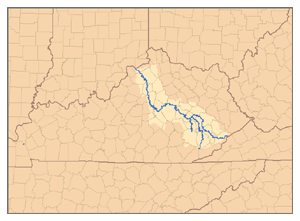Kentucky River
| Kentucky River | |
|---|---|
 | |
 | |
| Physical characteristics | |
| Mouth | Ohio River |
| Length | 259 mi (417 km) |
The Kentucky River is a tributary of the Ohio River, 259 mi (417 km) long, in the U.S. state of Kentucky. The river and its tributaries drain much of the central region of the state, with its upper course passing through the coal-mining regions of the Cumberland Mountains, and its lower course passing through the Bluegrass region in the north central part of the state. Its watershed encompasses about 7,000 sq. mi (18,000 km²). It supplies drinking water to about one-sixth of the population of the state.
The river is navigable along its length below Beattyville, KY because of a series of 14 locks built by the U.S. Army Corps of Engineers and now under the management of the state-run Kentucky River Authority. The primary importance of the locks today is to maintain a pool that allows the city of Lexington to draw its drinking water from the river. Despite the fact that the Lexington area receives well over 40 inches (1000 mm) of precipitation annually, the limestone, karst geology of that area means that surprisingly little natural surface water is found in the region.
Description

It is formed in eastern Kentucky at Beattyville, in Lee County, by the confluence of the North, Middle and South Forks at about 670 feet (204 m) elevation, and flows generally northwest, in a highly meandering course through the mountains, through the Daniel Boone National Forest, then past Irvine and Boonesborough, then southwest, passing south of Lexington, then north through Frankfort. It joins the Ohio at Carrollton.
Approximately 15 mi (25 km) southwest of Boonesborough it is joined by the Red River. Approximately 20 mi (30 km) southwest of Boonesborough it is joined by Silver Creek. At High Bridge, it is joined by the Dix River. At Frankfort, it is joined by Benson Creek. Approximately 10 mi (15 km) north of Frankfort, it is joined by Elkhorn Creek.
Between Clays Ferry in Madison County and Frankfort, the river passes through the Kentucky River Palisades, a series of dramatic steep gorges approximately 100 mi (160 km) in length.
According to Robert F. Collins of the United States Forest Service, Dr. Thomas Walker named the river, in 1750, Louisa River, after Princess Louisa, the wife of Prince William Augustus, Duke of Cumberland (Walker had just named the Cumberland River a month or two earlier). Over time the name Louisa became Levisa and shifted to the nearby stream today called Levisa Fork River.
Forks
North Fork

The North Fork Kentucky River is approximately 125 mi (201 km) long. It rises on the western side of Pine Mountain, in the Appalachians of extreme southeastern Kentucky, in eastern Letcher County near the Virginia state line. It flows generally northwest, in a winding course through the mountainous Cumberland Plateau, past Hazard and Jackson. It receives Rockhouse Creek at Blackey near its source. Approximately 8 mi (13 km) southeast of Hazard, it receives the Carr Fork. It receives Troublesome Creek at Haddix, southeast of Jackson. Three miles upstream from its confluence with the South Fork, it receives the Middle Fork. It joins the South Fork to form the Kentucky at Beattyville.
Middle Fork
The Middle Fork Kentucky River is a tributary of the North Fork Kentucky River, approximately 85 mi (137 km) long, in southeastern Kentucky in the United States. It rises in the Appalachian Mountains in extreme southeastern Kentucky, in northeastern Harlan County, approximately 5 mi (8 km) from the Virginia state line. It flows initially southwest, in the valley on the eastern side of Pine Mountain, then passes along the southeastern end of the ridge, flowing north through the Cumberland Plateau past Hyden. At Buckhorn, it is impounded to form the Buckhorn Lake reservoir. North of the reservoir it flows generally northwest and joins the North Fork in Lee County, approximately 5 mi (8 km) east of the confluence of the North and South forks at Beattyville.
South Fork
The South Fork Kentucky River is approximately 30 mi (48 km) long. It formed in Clay County, at the town of Oneida, Kentucky in the Daniel Boone National Forest, approximately 10 mi (16 km) northeast of Manchester, by the confluence of Goose Creek and the Red Bird River. It flows generally north in a highly meandering course through the mountainous Cumberland Plateau region. It joins the North Fork to form the Kentucky at Beattyville.
Recreation
The largest goldeye ever taken in the state of Kentucky (2 lbs, .64 oz.) was caught in the Kentucky River.[1]
References
- ^ "Kentucky State Record Fish List". Kentucky Department of Fish and Wildlife Resources. 2006-04-17. Retrieved 2007-02-17.
{{cite web}}: Check date values in:|date=(help)
- Collins, Robert F. "A History of the Daniel Boone National Forest". (1975)
- Arthur Benke & Colbert Cushing, "Rivers of North America". Elsevier Academic Press, 2005 ISBN 0-12-088253-1
- Rhodes, Captain Rick, "The Ohio River --In American History and Voyaging on Today's River" has a section on the Kentucky River, Heron Island Guides, 2007, ISBN 978-09665866-33
